NCERT Solutions Class 9 Science Chapter 3 - Atoms and Molecules
NCERT Solutions for Class 9 Science Chapter 3 – Atoms and Molecules are essential for understanding key Chemistry concepts in the CBSE curriculum. These well-structured answers help students grasp topics like laws of chemical combination, atomic theory, writing chemical formulas, mole concept, and more. Designed as per the latest syllabus, these solutions strengthen conceptual clarity and improve exam preparation. Ideal for revision and practice, they encourage logical thinking and scientific understanding, making them a valuable study tool for scoring well in Class 9 Science exams.
NCERT Solutions Class 9 Science – Atoms and Molecules – Exercise Images
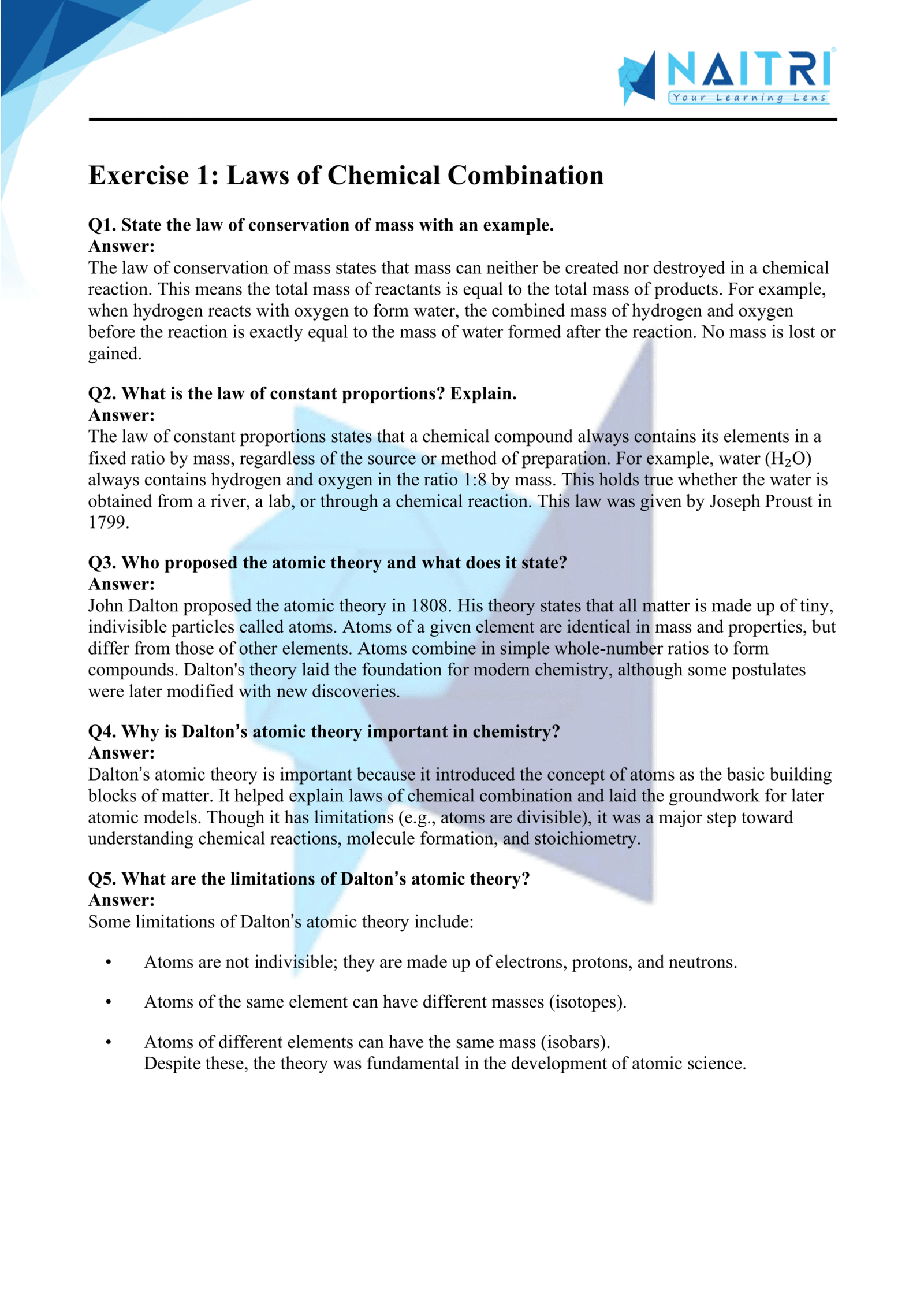
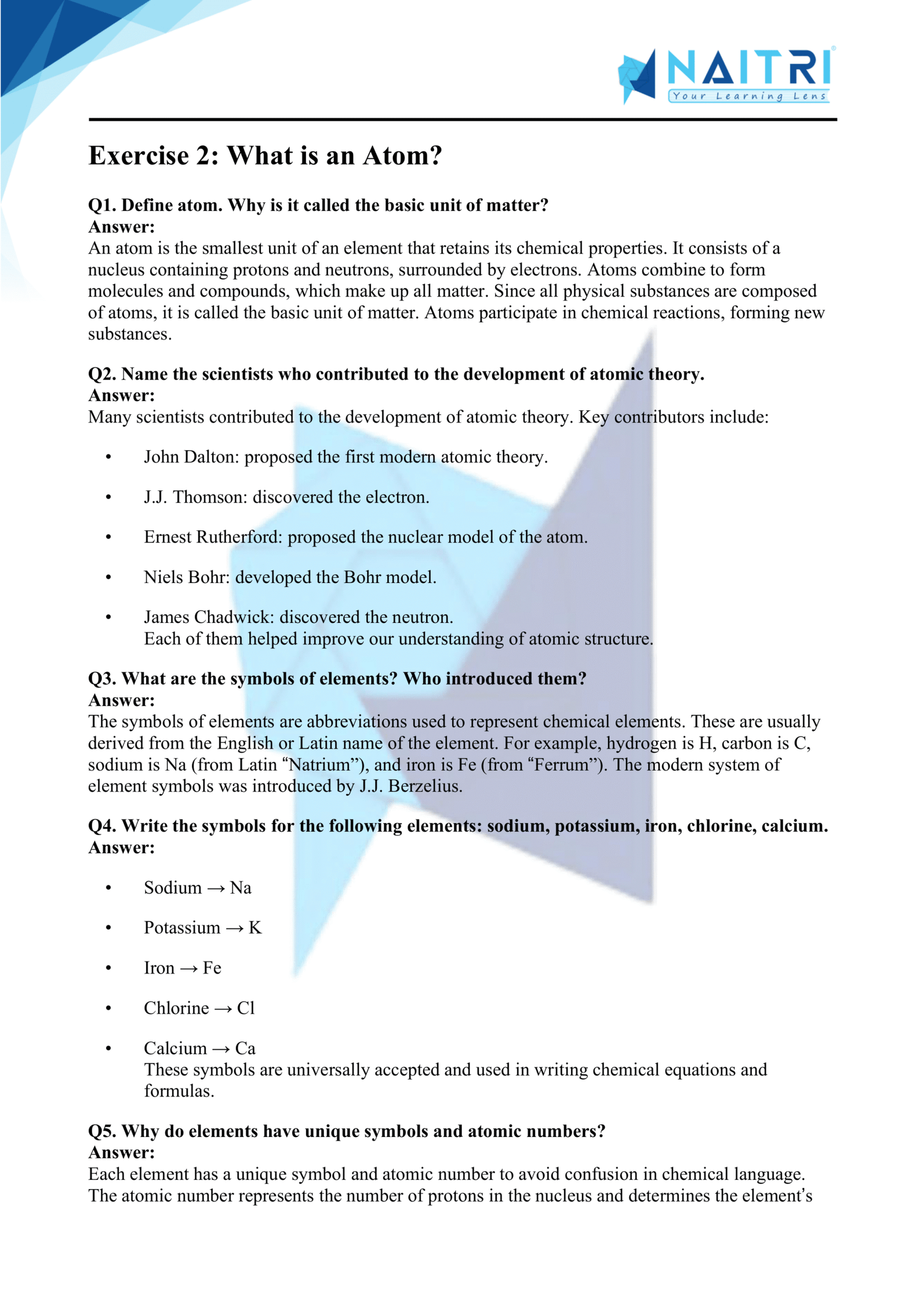
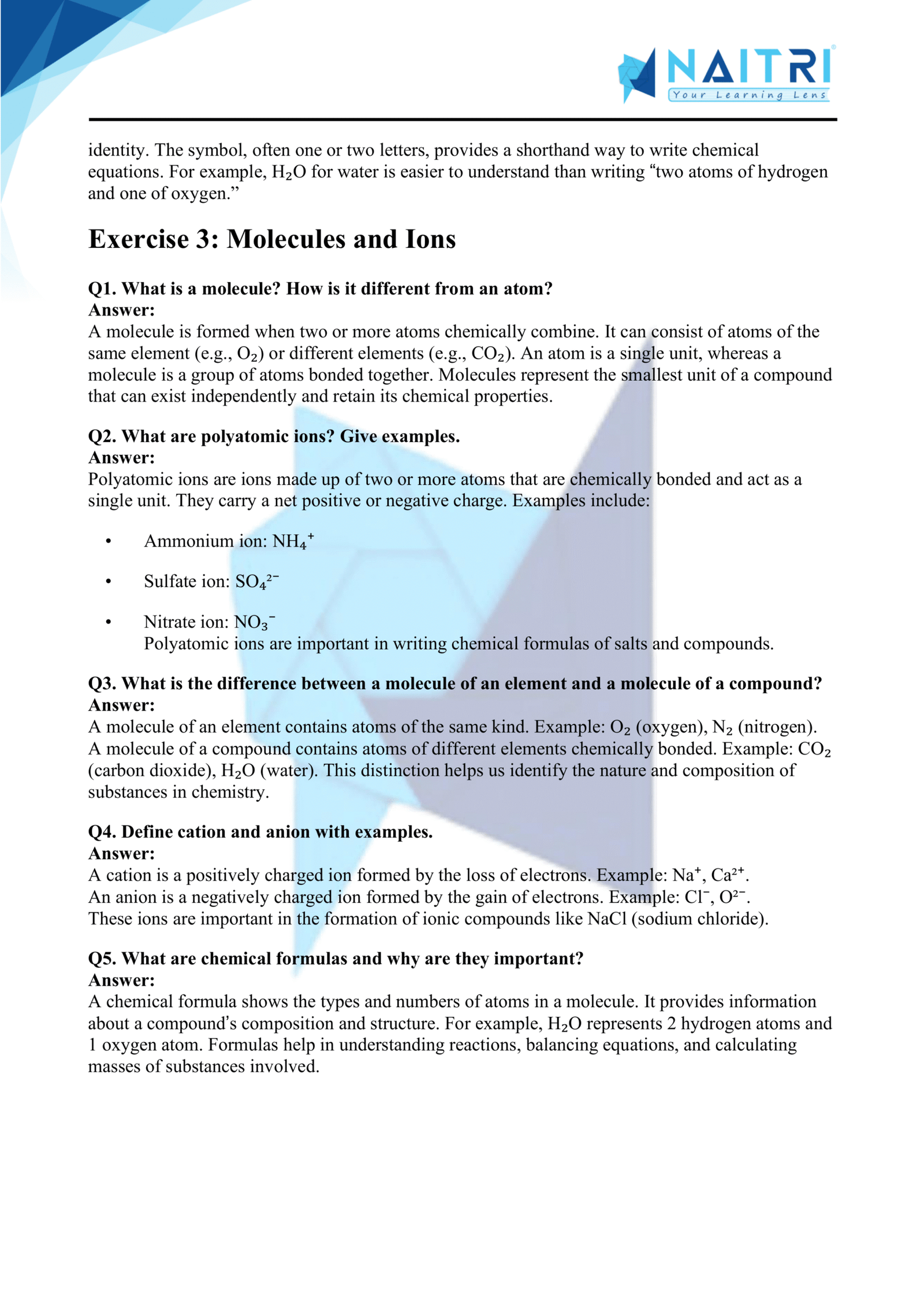
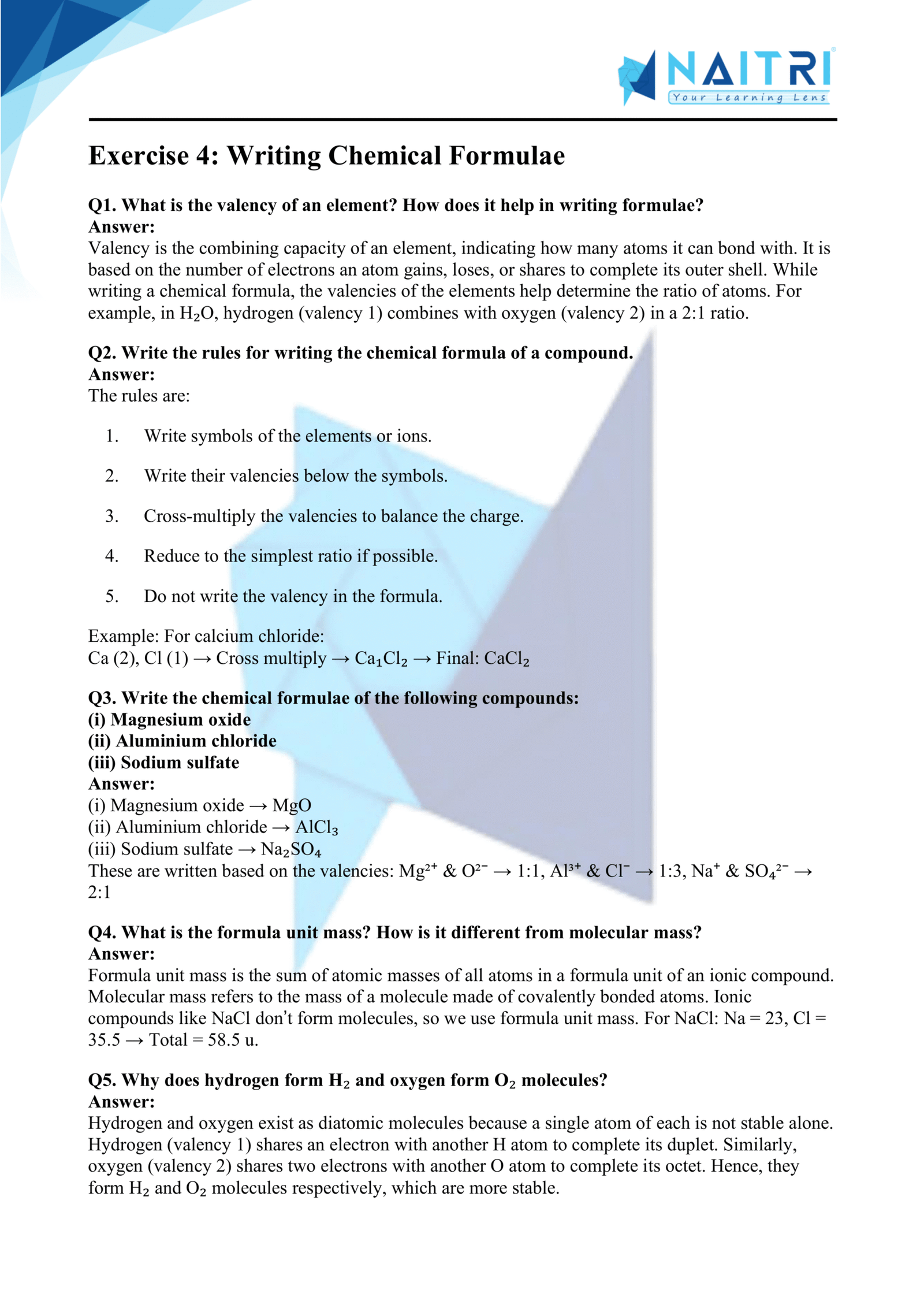
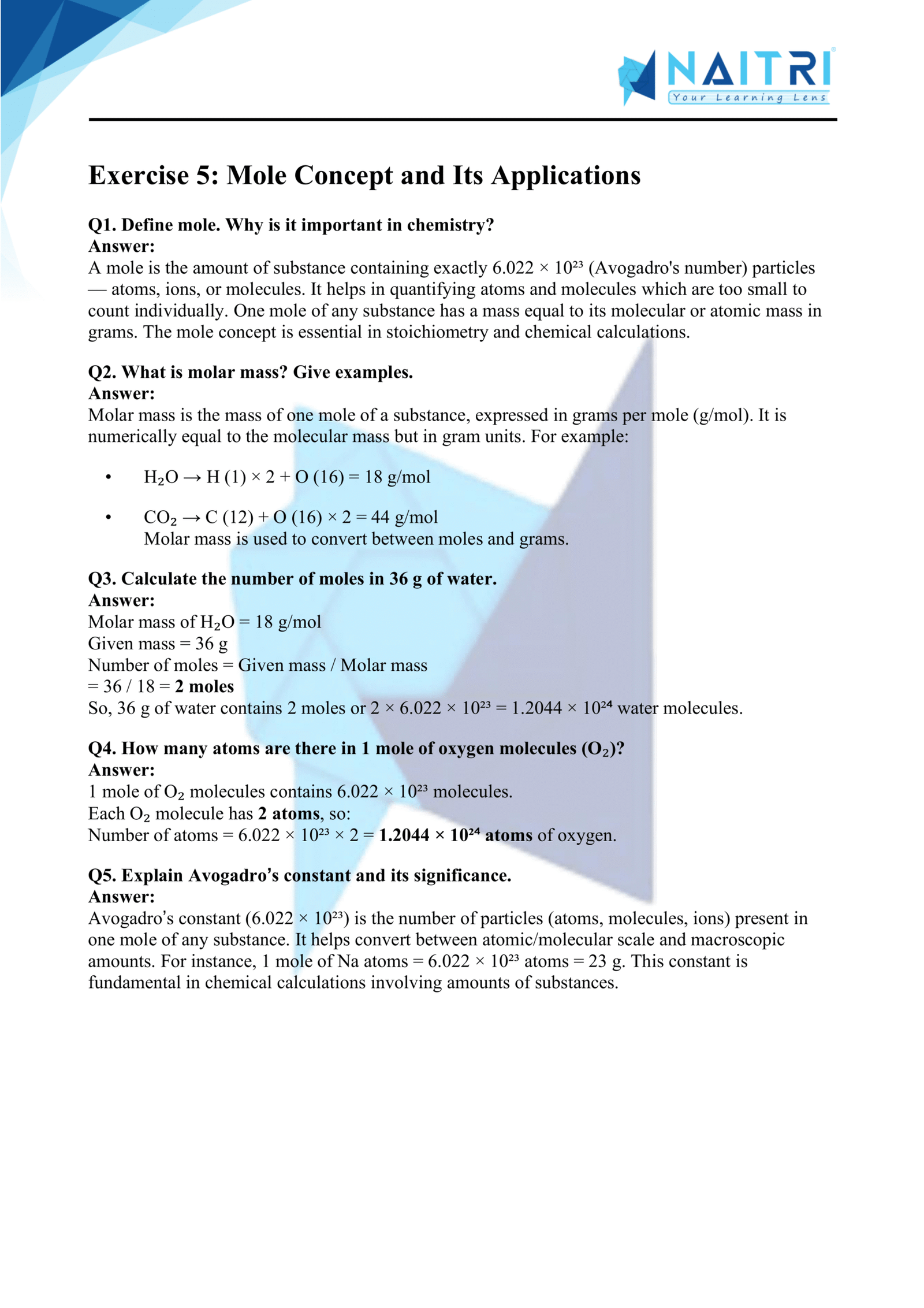
Experience Science Like Never Before – With AR!
Understanding Atoms and Molecules is now more exciting and immersive! With the NAITRI App, you can explore complex science concepts through Augmented Reality (AR). Watch atoms bond, molecules form, and reactions simulate in 3D — right in front of you. Our AR-powered lessons make learning interactive, 3D, and fun, helping you retain concepts better and enjoy every topic.



Visualize . Interact . Understand . The future of learning is here
Atoms and Molecules – Important Questions with Answers
1. Define atom.
Answer: An atom is the smallest particle of an element that retains the chemical properties of that element.
2. Define molecule. Give two examples.
Answer: A molecule is a group of two or more atoms chemically bonded together.
Examples: Oxygen (O₂), Water (H₂O).
3. What is a compound? Give two examples.
Answer: A compound is a substance formed when two or more elements chemically combine in a fixed ratio.
Examples: Water (H₂O), Carbon dioxide (CO₂).
4. State the postulates of Dalton’s atomic theory.
Answer:
All matter is made up of indivisible particles called atoms.
Atoms of the same element are identical in mass and properties.
Atoms of different elements have different masses and properties.
Atoms combine in simple whole-number ratios to form compounds.
Atoms cannot be created or destroyed in chemical reactions.
5. What is meant by atomicity? Give examples.
Answer: Atomicity is the number of atoms present in a molecule.
Examples: Oxygen (O₂) – Diatomic, Phosphorus (P₄) – Tetratomic
6. What is a chemical formula?
Answer: A chemical formula is a symbolic representation of a compound using the symbols of its elements and the ratio in which they combine.
7. Write the chemical formula for the following:
a) Ammonia
b) Carbon dioxide
c) Calcium chloride
Answer:
a) NH₃
b) CO₂
c) CaCl₂
8. What do you understand by valency?
Answer: Valency is the combining capacity of an element.
9. Find the valency of the following elements: Hydrogen, Oxygen, Nitrogen, Carbon.
Answer:
Hydrogen – 1
Oxygen – 2
Nitrogen – 3
Carbon – 4
10. Define ion. Give examples.
Answer: An ion is a charged particle formed by the gain or loss of electrons.
Examples: Na⁺ (positive ion), Cl⁻ (negative ion)
11. Differentiate between cation and anion.
Answer:
Cation is a positively charged ion (e.g., Na⁺).
Anion is a negatively charged ion (e.g., Cl⁻).
12. What is a molecular mass?
Answer: Molecular mass is the sum of the atomic masses of all the atoms present in a molecule.
13. Calculate the molecular mass of CO₂.
Answer:
C = 12 u, O = 16 u
Molecular mass of CO₂ = 12 + (16 × 2) = 44 u
14. What is a mole?
Answer: A mole is the quantity of substance containing 6.022 × 10²³ particles (Avogadro’s number).
15. What is Avogadro’s constant?
Answer: Avogadro’s constant is 6.022 × 10²³, the number of particles in one mole of a substance.
16. How many molecules are there in 2 moles of oxygen gas?
Answer: 1 mole = 6.022 × 10²³ molecules
So, 2 moles = 2 × 6.022 × 10²³ = 1.2044 × 10²⁴ molecules
17. What is the mass of 1 mole of water (H₂O)?
Answer: H = 1 u, O = 16 u
Molar mass = 2 × 1 + 16 = 18 g
18. Write the chemical names of the following compounds:
a) HCl
b) NaOH
c) CaCO₃
Answer:
a) Hydrogen chloride
b) Sodium hydroxide
c) Calcium carbonate
19. What is the formula unit mass?
Answer: The formula unit mass is the sum of atomic masses of the ions in an ionic compound.
20. What is the difference between molecular mass and molar mass?
Answer:
Molecular mass is measured in atomic mass units (u).
Molar mass is the mass of 1 mole of a substance in grams.
21. State the law of conservation of mass.
Answer: Mass can neither be created nor destroyed in a chemical reaction.
22. State the law of constant proportions.
Answer: A chemical compound always contains the same elements in the same fixed ratio by mass.
23. Calculate the number of atoms in 1 mole of methane (CH₄).
Answer: CH₄ has 5 atoms (1 C + 4 H)
1 mole of CH₄ = 6.022 × 10²³ molecules
Total atoms = 5 × 6.022 × 10²³ = 3.011 × 10²⁴ atoms
24. Write the chemical formula of:
a) Aluminium oxide
b) Magnesium chloride
c) Potassium nitrate
Answer:
a) Al₂O₃
b) MgCl₂
c) KNO₃
25. Name the following compounds:
a) Na₂SO₄
b) KCl
c) Ca(OH)₂
Answer:
a) Sodium sulphate
b) Potassium chloride
c) Calcium hydroxide
Atoms and Molecules introduces students to the basic building blocks of matter—atoms—and how they combine to form molecules. This chapter lays the foundation for understanding chemical reactions and the laws that govern them, such as the Law of Conservation of Mass and the Law of Constant Proportions. Students learn about symbols of elements, chemical formulas, and the concept of a mole, which helps quantify particles in a substance. Real-world examples and scientific reasoning are used to explain atomic and molecular structures, fostering a logical and curious approach to chemistry. Overall, this chapter is crucial for developing a clear understanding of how substances are formed and how they interact.
Related Chapters You May Like
- Chapter – 1 Matter in Our Surroundings
- Chapter – 2 Is Matter Around Us Pure
- Chapter – 4 Structure of the Atom
- Chapter – 5 The Fundamental Unit of Life
- Chapter – 6 Tissues
- Chapter – 7 Motion
- Chapter – 8 Force and Laws of Motion
- Chapter – 9 Gravitation
- Chapter – 10 Work and Energy
- Chapter – 11 Sound
- Chapter – 12 Improvement in Food Resources
Download Naitri App
Easy, Visual Learning — Right on Your Phone
Learn with Augmented Reality! The Naitri app makes CBSE and MP Board concepts interactive and fun — even in low-resource settings. Watch lessons, complete homework, take tests, and track progress — all in one place. Anytime. Anywhere.
Available on








